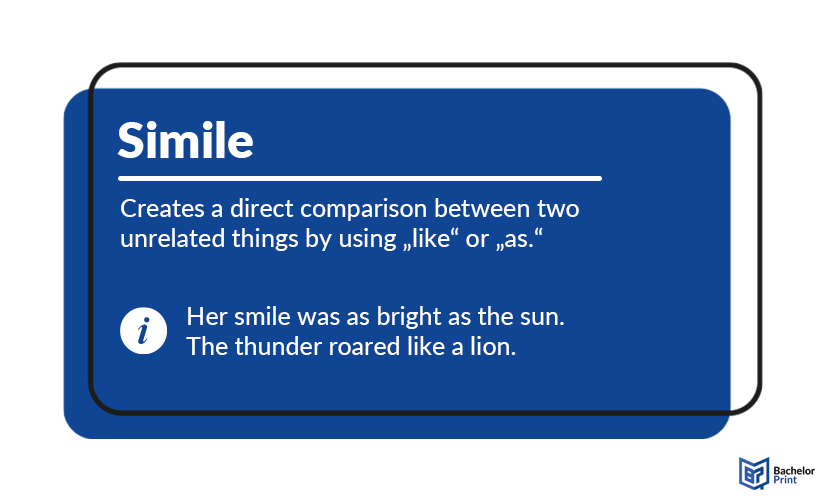
In academic writing, devices like the simile play a pivotal role in enhancing clarity and depth. A simile, a figure of speech that directly compares two distinct things using “like” or “as,” enables authors to create vivid imagery, facilitating a reader’s understanding of complex ideas. By drawing parallels between the familiar and the abstract, this stylistic device enriches both analytical and descriptive writing, making academic arguments more engaging.
Definition: Simile
A simile (pronounced as SIM-uh-lee) is a stylistic device used in language to make a direct comparison between two seemingly unrelated things by using the connecting words “like” or “as.” By linking an abstract concept, like a personality trait or feeling, to a familiar object or image, this figure of speech brings clarity and impact to descriptions. This surprising comparison creates vivid imagery and enhances descriptions by highlighting a particular quality that both nouns or actions share, similarly to adjectives. Unlike metaphors, which imply a direct identification between two things (e.g., “the world is a stage”), similes maintain a separation between the elements while emphasizing their similarity in a specific way.

in Your Thesis
Types
The etymology of this device traces back to the Latin word “similis,” meaning “similar” or “like,” which reflects its function in the English language as a tool for comparison. Over time, various types have developed, each with unique characteristics and uses. Here are some of the most notable types.
This is the most common type, where two unlike things are directly compared with “like” or “as” to emphasize a shared quality. These similes are direct and simple, enhancing descriptions without extended detail.
The homeric simile (also called epic or extended simile) was named after Ancient Greek writer Homer. This type is often found in epic poetry and elaborates on the comparison over several lines to intensify the description.
This type underlines a specific quality or characteristic and paints a clear picture by using precise descriptions without the direct use of “as” or “like.” It subtly implies similarity without equating one thing with another like a metaphor would.
This type combines simile and hyperbole by using exaggeration to intensify a description. This creates a vivid image for humorous or dramatic effect.
This direct comparison uses the elements of irony by conveying the opposite of what is meant. This irony-simile combination creates a contrast for humorous effect.
A metaphorical simile combines a direct comparison with a metaphor, often carrying a deeper symbolic meaning beyond the comparison.
This type combines personification with simile by attributing human qualities to non-human entities through comparison.
Examples
Similes allow us to draw vivid comparisons that aren’t meant to be taken literally but help to convey qualities or emotions in a relatable way. Though often highlighted in literature and poetry, similes also enrich everyday language, shaping the way we express ourselves in conversation. Below are numerous examples that illustrate how this device is used to enhance meaning and create imagery.
Direct comparisons are typically found in novels, poems, or stories to evoke emotions and deepen thematic meaning. A hunt for similes within a text offers insight into how authors use language creatively to paint memorable scenes. Below are three well-known examples.
This stylistic device is used in lyrics to convey emotions or create memorable phrases.
Oftentimes, these devices are used in marketing, advertisement, or media to make products or ideas more memorable and relatable.
Simile vs. metaphor
These two figures of speech are both used to make figurative comparisons, but they do so in slightly different ways. What their differences are, will be explain below along with an example.
Simile
Compares two distinct things directly using “like” or “as” to highlight specific similarities.
Metaphor
Makes an implicit comparison by stating that one thing is another, omitting “like” or “as.”
These examples depict that a metaphor can be more powerful and symbolic than a simile that directly compares elements. The latter allows us to understand qualities or characteristics by drawing clear parallels, but keeps the compared elements separate. In contrast, metaphors suggest a deeper connection by merging the two elements, creating a stronger, sometimes more emotional impression.
So, when we say, “He is a real rat,” we imply that the person embodies all the traits associated with a rat (such as deceit or slyness) rather than merely sharing some similarities. This merging of qualities in metaphors often gives them a greater impact.
Simile & metaphor worksheet
Practice recognising their differences in the sentences below. Try identifying whether each sentence uses a direct or symbolic comparison, and think about what qualities are being compared.
- Her kids always fight like cats and dogs.
- His daughter is a shining star.
- The night was as quiet as a whisper.
- He has a heart of gold.
- She swam through the water like a fish.
- Life is a rollercoaster with many ups and downs.
- The new manager acts like a drill sergeant.
- His smile was as bright as the sun.
- This classroom is a zoo today!
- She runs like the wind on the track.
- Her kids always fight like cats and dogs.
This one directly compares the kids’ constant fighting to the famous brawl between cats and dogs by using the word “like.”
- His daughter is a shining star.
This sentence is a metaphor, as it states that one thing is another. The daughter is compared to a “shining star,” which symbolizes her brightness or excellence.
- The night was as quiet as a whisper.
Here, the simile directly compares the stillness of the night to the softness of a whisper, which emphasizes the calm and silence.
- He has a heart of gold.
A common metaphor that compares his heart to gold, meaning he is kind and generous person.
- She swam through the water like a fish.
The simile compares her swimming ability to that of a fish with the word “like,” meaning that she is a very skilled swimmer.
- Life is a rollercoaster with many ups and downs.
The metaphor compares life to a rollercoaster, which symbolizes the unpredictable highs and lows of life.
- The new manager acts like a drill sergeant.
The manager’s strictness is directly compared to that of a drill sergeant with the use of a simile, suggesting that he is well-disciplined and in control.
- His smile was as bright as the sun.
The powerful simile directly compares the brightness of his smile to the sun. This suggests warmth and radiance.
- This classroom is a zoo today!
The metaphor compares the chaotic atmosphere of the classroom to a zoo, which suggests noise or wild behaviour.
- She runs like the wind on the track.
This direct comparison using “like” emphasizes the grace and swiftness of her run.
- ✓ Free express delivery
- ✓ Individual embossing
- ✓ Selection of high-quality bindings
FAQs
It is a figure of speech that compares two distinct things using the linking words “like” or “as” to highlight a particular quality they share. The purpose of a simile is to create vivid imagery, making descriptions more relatable and memorable for the reader. By connecting an idea to something familiar, these devices help clarify complex concepts and evoke strong emotions or visuals.
An example is:
Her smile was as bright as the sun.
A simile uses “like” or “as” to make an explicit comparison between two things (e.g., “He runs like the wind“), clearly stating the similarity.
A metaphor makes an implicit comparison by stating that one thing is another (e.g., “He is a golden star”), suggesting a deeper connection or symbolic meaning.